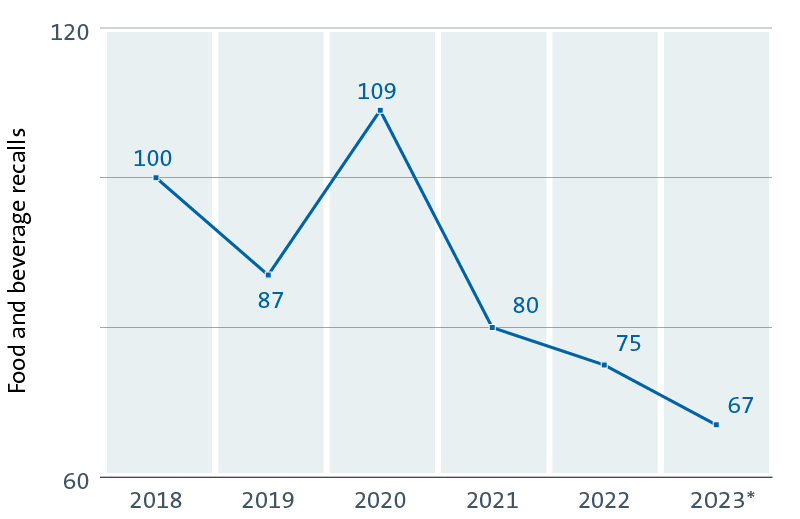By Jaime McKenzie, Zoe Chapman and Nick Li
Key takeaways
![]()
Shareholder, employee and franchisee-related class actions are key areas of class action risk for the food and beverage sector.
![]()
Consumer and shareholder class actions continue to dominate, accounting for 75% of all class action filings in 2023.
![]()
Food and beverage-related recall levels look to be higher in 2023 than last year, continuing the overall slight upward trend over the past 10 years.
A return to elevated class action filings, with a focus on consumer and shareholder claims
Our interim update on class action risk in 2023 identified a rise in class action filings in 2023. There were 28 class actions filed to 30 June 2023, double the 14 filed over the equivalent period in 2022, signalling a return to the elevated filings of 2017–21.
The increase has been fuelled by a rise in competing class actions and the first wave of data breach class actions following several high-profile data breaches. While the majority of class actions are filed in the Federal Court, filings in the Supreme Court of Victoria are significant, too, as plaintiff firms continue to pursue group costs orders (ie contingency fees).
Consumer and shareholder class actions continue to dominate, being over 75% of filings. Data breach class actions have emerged as a new type of consumer claim. While most shareholder claims focused on earnings guidance, there continues to be a growing trend of shareholder claims based on disclosures concerning alleged inadequate corporate governance, systems and controls. On the other hand, the rate of employment claims is dwindling.
More specifically to the food and beverage sector, the data from 2018–23 reveals three main areas of class action risk:
- five shareholder class actions against listed food companies (all relating to earnings guidance)
- seven employee class actions against food and retail companies alleging underpayment and/or inadequate breaks
- three franchise-related class actions alleging breaches of franchise agreements.
Product recall trends

Number of food and beverage recalls in Australia (FSANZ, 2023)
*2023 data up to 30 September 2023
Over the past 10 years, there has been a slight upward trend in the total number of food and beverage product recalls. Numbers have remained reasonably steady over the past five years.
The number of recalls peaked in 2020, and then trended down slightly in 2021 and 2022. Based on the data available for 2023 to date, recall numbers appear to be trending up again slightly. Sixty-seven recalls have been notified so far in 2023, compared to 75 recalls in the whole of 2022. In both years, approximately 90% of recalls related to food products—the remaining 10% to beverage products.
Undeclared allergens were the leading reason for product recalls in 2022 (29), and to date in 2023 (34) (and indeed in most other years). It is not uncommon to see a spike in labelling-related recalls for years where a labelling regulatory change is being implemented.
Microbiological contamination is usually the second-most common reason for voluntary recalls each year.
One divergence in 2023 is a steep reduction in the number of products recalled for the 'potential presence of chemicals'—from eight in 2022 to one in 2023. This was predominantly due to high levels of thebaine in poppy seed products being identified in 2022 as a result of non-food-grade poppy seeds entering the human food supply chain. On the other hand, there has been an increase in the number of products recalled for non-compliant labelling, from three in 2022 to 10 so far in 2023—these include labels:
- missing ingredients
- with incorrect best by/before dates resulting in increased listeria monocytogenes risk
- with no direction to keep the product refrigerated.
FSANZ attributes several factors to the upward trend in total food and beverage recalls, including continued advancements in food technology, analytical testing and traceability leading to an increase in total recalls.
The recall statistics highlight that recalls are underscored by a combination of food safety and labelling factors—both of which must be borne in mind to reduce the incidence of a recall arising.





